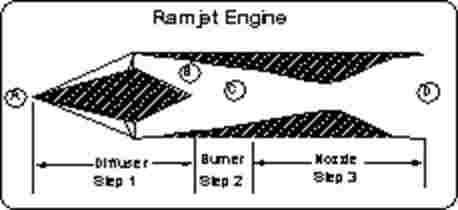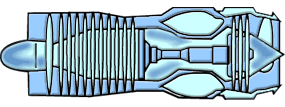Aircraft Engine Design
The conservation of momentum and mass across the above control volume above gives the equation governing the thrust produced by the engine. This thrust comes from two factors; the momentum thrust and the pressure thrust. For the aircraft to have acceleration of zero or above the thrust produced must be equal to or greater than the drag of the aircraft. The higher the velocity of the jet exhaust, the higher is the thrust produced. But so are the losses involved. The high velocity jets mean that the mass flow rate required is a lot lesser than that of a low velocity jet to produce the same thrust. The advantages of the low jet velocity engines are that they have better efficiency and perform very well at mach numbers below one. So what types of air breathing engines are there?? The simplest is the ramjet, as the name indicates the engine uses the speed of the aircraft to compress air by ramming effect and then heats it in a burner. Then it is expanded through a nozzle increasing its velocity and thus generating thrust.
Figure1: Schematic of a ramjet The next in the order of simplicity is the turbojet.
Instead of using the aircraft’s speed to compress the air, it uses a
compressor. It can take of from rest unlike a ramjet, which has to be first
accelerated to high velocities before it generates any thrust. The compressor
draws its power from a turbine, which is in turn run by expanding the hot
gases through to produce just enough work.
Figure 2: Schematic of a turbojet. The next in line is the turbofan. It uses a fan to
increase the pressure of the bypass stream. This separate stream of air is
either mixed back with the main core stream or exhausted separately giving
rising to different configurations. Each has its own set of advantages and
shortcomings.
Figure 3: An F110 mixed flow turbofan engine.
Then there are combined cycle engines Read about them here
|
|
Aircraft engine design is a fascinating subject. And one that demands total devotion. Some books and sites that I refer to are listed below. ·
Elements of Gas Turbine Propulsion by
Dr. Jack Mattingly. ·
Aircraft Engines by Jack Kerbrock ·
Practical Intake Aerodynamics by Goldsmith. ·
Visit the MIT
Open Course Ware site for Aircraft engine design courses online
|


